

Vol. 39 (# 04) Year 2018. Page 37
Aliya K. BUTKENOVA 1
Received: 18/11/2017 • Approved: 30/11/2017
ABSTRACT: The relevance of the issue is caused by the demand of modern society for high-quality labor, personnel to solve the tasks of the industry and the development of production, especially in the Republic of Kazakhstan. The demand for semi-skilled employees decreases due to the development of technologies and labor means replacing the human workforce. The knowledge, skills and competencies of employees, necessary for the modern production sector, become an important factor in the industry. It happens due to the fact that such knowledge, skills and competences are currently required not only from engineering employees, managers and office management personnel, but also from employees who should be able to work with modern equipment with modern technologies. The complex of these skills, knowledge and skills is exactly the human capital of a company, which is formed for quite a long time due to recruitment and selection of personnel, advanced training and development, while it is a very complicated process. The purpose of the document is to study the formation of human capital assets, strategic planning of human capital assets in modern industrial enterprises of Kazakhstan. The main method to study the subject is the strategic analysis (according to the data of the KazStat (statistical agency RK) and other strategic data), as well as selective questionnaires (survey) of the directors of the companies. This document presents the main approaches of the notion of "human capital assets". The document materials represent a practical value for the industrial companies of Kazakhstan and other countries for the activities related to personnel management. |
RESUMEN: La relevancia del tema es causada por la demanda de la sociedad moderna de mano de obra de alta calidad, el personal para resolver las tareas de la industria y el desarrollo de la producción, especialmente en la República de Kazajstán. La demanda de empleados semicalificados disminuye debido al desarrollo de las tecnologías y los medios laborales reemplazando a la fuerza laboral humana. El conocimiento, las habilidades y las competencias de los empleados, necesarios para el sector de producción moderno, se convierten en un factor importante de la industria. Sucede debido al hecho de que tales conocimientos, habilidades y competencias se requieren actualmente no solo de los empleados de ingeniería, gerentes y personal de administración de oficinas, sino también de los empleados que deberían poder trabajar con los equipos modernos con las tecnologías modernas. El complejo de estas habilidades, conocimientos y competencias es exactamente el capital humano de una empresa, que se forma por un tiempo bastante largo debido a la contratación y selección de personal, capacitación avanzada y desarrollo, mientras que es un proceso muy complicado. El objetivo del documento es estudiar la formación de activos de capital humano, la planificación estratégica de activos de capital humano en las empresas industriales modernas de Kazajstán. El método principal para estudiar el tema es el análisis estratégico (de acuerdo con los datos del KazStat (agencia de estadística RK) y otros datos estratégicos), así como cuestionarios selectivos (sondeo) de los directores de las empresas. Este documento presenta los principales enfoques de la noción de "activos de capital humano". Los materiales del documento representan un valor práctico para las empresas industriales de Kazajstán y otros países por parte de las actividades relacionadas con la gestión del personal. |
The economy of Kazakhstan, being the market economy, implies existence and operation of independent private companies in all the spheres of economic activities, including industrial sector. The industrial sector currently employs a great number of private companies and the companies partially owned by the government (including those, 100%-owned by the government). However, every company is an independent legal entity planning its activities and elaborating the development strategy. The strategy of every enterprise is undoubtedly connected with definition of the enterprise’s position on the market, with the focus on particular market segments, and with provision of resources. All of this should be planned for a long-term period considering possible changes in the market, activities of the partners, state regulation and influence of other factors. A great emphasis is usually laid on provision of activities of any enterprise with resources. It includes provision with material resources (feedstock, materials, part finished items, and means of production) as well as workforce. The workforce as an important component of the enterprise resources ensures effective use, including, of material resources, because the workforce also consists of the high-qualified personnel’s labor of both frontline and engineering staff employees (hereinafter – ESW), and the management, including top-management of the company which is also employed by contract, approved by the owner (shareholder).
Considering the importance of provision with human resources and the need for a specific high qualification of these resources for efficiency of the enterprise, it is necessary to plan the resources, focused management of their formation, quality and development. All of this is implemented as part of the human capital assets management strategy, which the paper exactly deals with.
Beginning from 1991, the economy of Kazakhstan develops as the market one in the conditions of a relatively free, though state-regulated, market. Over these years the country has already formed the labor market, which is also free, even despite there are some drawbacks. Nowadays every person may really choose any activities for him/herself: to acquire higher or secondary vocational education, or to go without any education, to work for hire in a private company, to work in state bodies, government-funded organizations, or to be a private entrepreneur, which is guaranteed by the applicable Constitution of the Republic of Kazakhstan.
Specific and obvious problems of the Kazakhstani market development are close to the problems also existing in other countries, particularly in Russia. And it is noticed by various researchers. In Kazakhstan, the same as in Russia and other EEU states there are rather low salaries among the professions connected with semi-skilled and unskilled labor (Vukovich, 2012, pp. 16-20). At their differentiation by the regions (in Almaty and Astana, Kazakhstan, the level of salaries is traditionally higher) among the local population there are not enough people who wish to work for these salaries, so the market is often filled by both internal migrants from the rural area and the guest employees from the neighboring countries (Kyrgyzstan, Uzbekistan, and Tajikistan), which is also generally peculiar to the market of large Russian cities and it is noted by both the Russian (Igoshina, 2016) (Shustova, 2011, pp. 25-29), and Kazakhstani specialists (Akhatova, 2014). Besides, the modern Kazakhstani market may be also characterized with a high percentage of self-employed population in the sphere of agriculture (nevertheless, this employment far from always covers the basic human needs and ensures due living standards), and with high youth unemployment, which is reflected in the paper by E. Kh. Akhatova (Akhatova, 2014), S. Iskendirova and D. Aglankyzy (Iskendirova and Aglankyzy, 2015). The problem of Kazakhstan the same as of Russia and other EEU states is despite a large number of universities’ graduates, many of them remain non-demanded in the labor market by their specialties. But the positions by a series of professions requiring high qualification, vice versa, are filled quite slowly (and currently such professions are doctor, structural engineer, teacher, to some extent even lawyer and IT-specialist, if speaking about the specialists with a significant practical experience) (Mustafina, 2015). A relatively low unemployment level in Kazakhstan –according to KazStat it decreased from 7.3% in 2007 to 5% in 2016, also provokes criticism, because the “unemployed” are considered only those who are officially registered in the unemployment centers. Those who are not registered there and the “ineffectively unemployed” are not considered. Taking into account the fact that the unemployment benefits in Kazakhstan are small and the efficiency in the search of job through state authorities is doubtful, one may say that the unemployment level is underestimated, which is peculiar not only for Kazakhstan, is reflected in the paper by S. A. Selimova (Selimova, 2016, p. 35), Р. Ivanovа (Ivanov, 2017).
While in general for transition of Kazakhstan from resource-based to innovation economy, which was particularly defined in the “Kazakhstan-2050” Strategy, it is necessary to radically change the approach to formation of human resources and their management. It is necessary to be implemented not only at the state level, but also at the level of enterprises, first of all, of large companies having significant capacities and resources for implementation of a new type of personnel policy. As part of the modern approach towards HR-management it is supposed to emphasize on formation of the organizational culture contributing to the conditions of constant training and development of the personnel, teambuilding, obtaining by the employees of satisfaction from their jobs, and development of the incentive systems. As the leaders currently pay a special attention to such issues as development of new organizational culture, formation of a single system of organizational values, then they will form such qualities of their workforce and each employee as knowledge, professionalism, loyalty, ability to work in team, and willingness to embrace change. Even now these qualities are the main guarantors of increase in the quality of the production processes, improvement of the production quality and satisfaction of the consumers’ needs. So, integration of the people’s intellect, development of their initiative, creativity, innovation, need for achievement and independent actions, decision-making, recruitment of the professionals, creation for them of such conditions that would contribute to their wish to perform are important areas of the human capital assets management strategy, which is noted, particularly, in the paper by Academician B. Zh. Yermekbayeva and Professor of Al-Farabi Kazakh National University K. S. Mukhtarova (Yermekbayeva, Mukhtarovа, 2016). That is exactly why this paper deals with the issues of strategic management and planning of human capital assets.
First of all, it should be elaborated what is object, subject and goal in strategic planning of assets at industrial enterprises. The subject, as follows from the definition is the industrial enterprise itself. It means the enterprise releasing the industrial products of any production area (from mining production to different types of processing industry). In this case the object is the personnel of the enterprise, the workforce jointly representing the human resources or “human capital assets”, and which may be estimated in a certain way. And the goal here is the increase in the quality human capital assets through application of the strategy, its planning and implementation.
It is necessary to dwell on the object, which is the human capital asset of the enterprise. Human capital assets are formed from “human resources”. In general, by the term “human resources” one usually mean the staff composition of the organization, but not quantitatively or functionally and technically, but qualitatively. This term is applied not only to a specific organization, but to an industry, region and country (Balashov, 2009, р. 14). The difference of the notion of “human resources” from the traditional notions of “staff”, “personnel”, “workforce”, “labor resources” is concluded in presence, except for the traditional attributes peculiar to the elements of the defined complex, of specific attributes, which may be connected with the following aspects, studied, in particular, by A.I. Balashov and I.D. Kotlyarov (Balashov et al., 2012, p. 98), such as:
– capacity for creativity, potential opportunities of well-rounded development for the employees;
– general culture and moral reliability of the employees;
– certain effect of cooperation and self-organization in the team (capacity for collective forms of labor organization and decision-making);
– improvement of job relationships in the team;
– incentives;
– initiative.
It means, if the content of such notions as “staff”, “personnel”, “workforce”, and “human resources” are connected with functional, technocratic attitude towards the employee, correspond to the concept of “economic person”, the term “human resources’ expresses personal approach, corresponding to the concept of “social person”. This term is also closely connected in its sense and correlates with such terms as “workforce capacity”, “labor potential”, and ‘intellectual potential”. In general, by “economic capacity of enterprise” is meant the presence there of the resources closely interconnected with each other (fixed assets, human resources, technologies, and management resources) (Sheshukova and Kolesen’ 2011, pp. 118-127). So, labor potential is one of the key categories, which is a component of the economic capacity of an enterprise. V.S. Vasilchenko and coauthors define labor potential as intellectual characteristics, knowledge, skills peculiar to human resources (population) in a country, a region, and at an enterprise. It means, labor potential at the micro-level (labor potential of a specific enterprise) has the same characteristics connected with the knowledge, skills and capacities (Vasilchenko et al., 2005, p. 14). Labor potential is a qualitative characteristic, reflecting the capacities of performance by the staff of an enterprise or participation of the population of a region in some specific economic activities. Here close to the notion of “labor potential” term “workforce capacity”, defined by Т.В. Berglezova as “skills of the employees that may be used for raising his or her performance in various spheres of production in order to gain the income (revenues) for achievement of social effect” (Berglezova, 2015). Therewith, L.F. Sukhodoyeva divides workforce capacity into “internal” and “external”, where external is the capacity of the potential employees of an organization, who may be recruited to the team, while internal capacity is the knowledge and skills of the current members of the team (employees of the organization) (Sukhodoyeva, 2007, pp. 165-167). Workforce capacity as a category is close to the notion of “human capital assets”. This term means the complex of knowledge, skills and competences that may be used to satisfy various needs of a person and society in general and was coined in 1961 by T. Schultz. Human capital assets may be divided into different levels (individual, corporate and national) (Schultz, 1968, p. 84). Human capital assets as a management object at both the level of organization and macro-level (region, state) may be affected by a proper development management system and investments (into the training and advanced training), in the organization it is also selection (through recruitment, attestation etc.) (Khudobko, 2011, pp. 7-17), while at the macro-level it is migration policy (attraction of high-qualified specialists, retention of high-qualified specialists, given that their outflow to other regions and countries, vice versa, decreases the human capital assets of the region or of the country) (Zulpuyev, 2016, pp. 68-75).
Some researches, studying the issues of workforce capacity of an organization, highlight its structural elements. In particular, G. V. Atamanchuk highlights the following structure of workforce capacity of an organization (of a state body), which is represented at Figure 1 (i.e. it consists of the intellectual capacity, social capacity, potential professional experience and integrative capacity) (Atamanchuk, 2014, p. 29). Each of these elements of the workforce capacity structure, represented at Figure 1 is a relatively independent area of the employee’s self-realization in development, first of all, his or her personal traits as an open educational system. Therewith, use of workforce capacity implies involvement into the current activities of the available, often hidden and unexploited opportunities, the abilities of an employee non-demanded earlier. Such reserve may be used at change of working environment, scheduled or foreseen. In such case the employee would have acquired the potentially necessary knowledge in advance and could have trained useful skills.
S. A. Mirosedi and A.V. Schedrina state that the workforce capacity of an enterprise should and can be a measurable value (Mirosedi, Schedrina, 2014). The quantitative characteristics are connected with those indicators, which are used at staff planning and analysis. Staff planning, in the context of which the coefficients of workforce capacity are calculated, is connected with the use in the calculations of only those values that are connected with the personnel turnover, planned rotations, age and qualification structure and other indicators called “real indicators of the state”; it is not sufficient. These quantitative “real” indicators only reflect the state of the labor potential, characterizing the opportunities and capacities of the employees for labor, but not its workforce capacity. While qualitative measurement is connected with the conducted attestation and definition by a series of criteria of different types of capacities and competences of every employee (e.g., by the classification represented at Figure 1), and based on the evaluation of every employee – definition of human capital assets of the whole organization.
Figure 1
Structure of Workforce Capacity of Enterprise
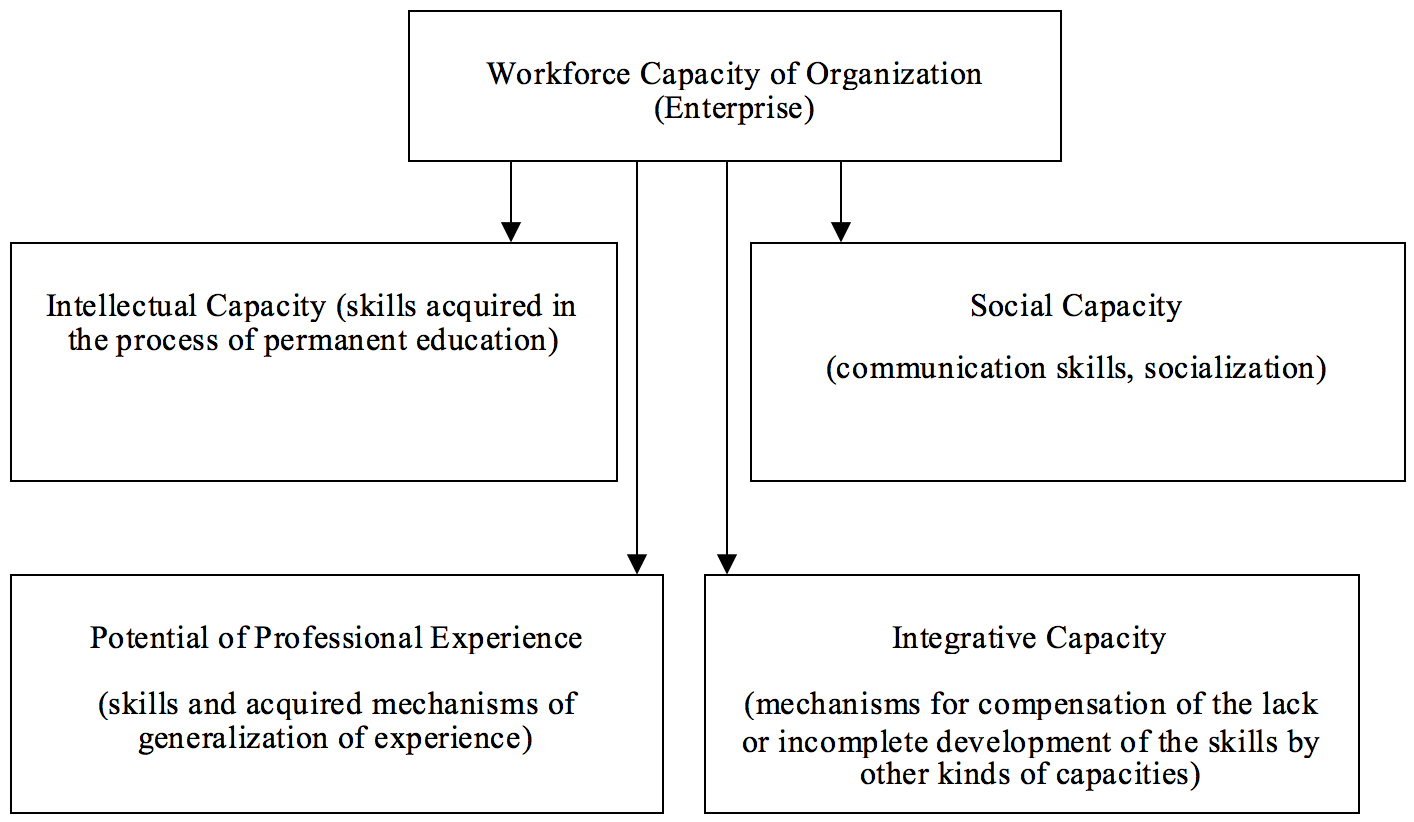
Source: prepared by the author according to (Atamanchuk, 2014, p. 34)
Anyway, the composing assessments of the workforce capacity of an enterprise may be represented as follows (Fig. 2).
Figure 2
Assessment of Workforce Capacity of Enterprise
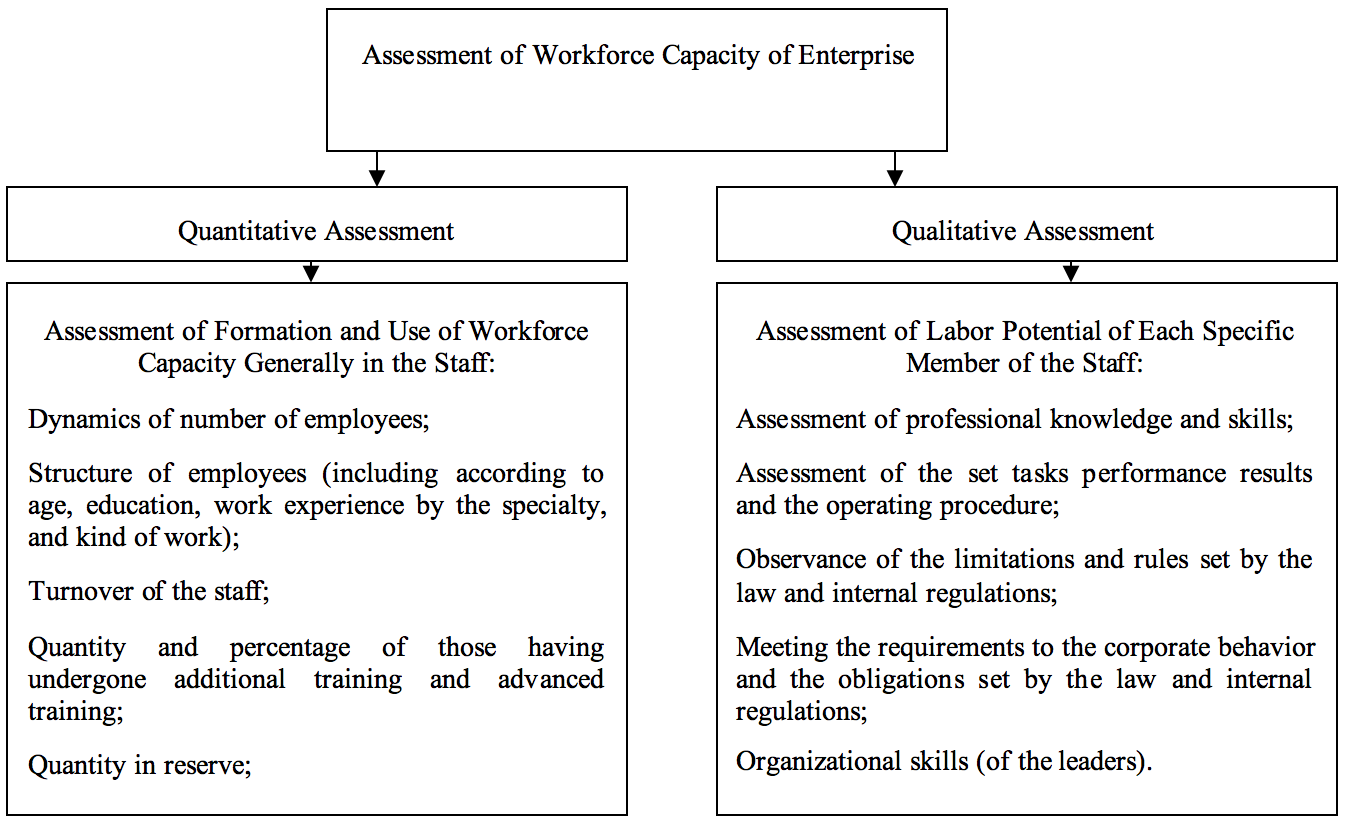
Source: prepared by the author according to (Mirosedi, Schedrina, 2014)
It means that quantitative indicators in this case show how exactly the workforce capacity is formed and exploited, while the qualitative indicators characterize the labor potential of each employee of the enterprise, which generally is the workforce capacity of the entire team.
Quantitative assessment of human capital assets is not a simple task, which is noted, particularly, by A.K. Butkenova, because human capital assets is not a typical asset which may be reflected in the enterprise balance (Butkenova, 2013, p. 87). Human capital assets may simultaneously be the largest potential asset and the highest potential responsibility, which is acquired by the organization by forming this capital asset. Human capital assets may be considered as a complex of investments into the personnel of the enterprise and into the management and development of the personnel. However, to define its size exactly is often impossible, and if to use the terms of IFRS, then human capital assets are rather a specific share of “goodwill” of the company. It is a different matter, that the efficiency of certain elements connected with formation of human capital assets may be assessed separately, but it will be quantitative assessment rather than qualitative. For example, efficiency of using personnel reserve may be defined by the following formula:
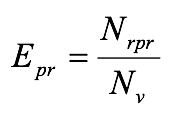 (1)
(1)
Where Epr – efficiency of using personnel reserve;
Nrpr – number of positions filled with the representatives of personnel reserve;
Nv – number of vacancies.
It is also possible to assess the turnover of personnel reserve as the ratio of the reservists leaving it to the average value), readiness of the reserve (as the number of key positions, for which the reserve is created, to the number of such key positions) etc. (Chernenko, 2013, pp. 67-74).
So, one may conclude that the workforce capacity of an enterprise is a complex of knowledge, skills, experience and competences of the employees of this working team, that are exploited or may be exploited in the main activities of the enterprise. The structure of workforce capacity includes intellectual capacity, social capacity, potential of professional experience and integrative capacity as components. Therewith, assessment of workforce capacity may be quantitative (it reflects the process of formation and exploitation of this capacity in every specific organization based on actual data) and qualitative (it reflects subjective opinion of the attestation commission on the capacities of each employee, his or her compliance with the set level of competence in various areas of labor potential or may be measured another way if it is possible). Workforce capacity of an enterprise is its human capital assets, which is the complex of accumulated knowledge, skills, employees’ experience and which may be efficiently used, improved through training (advanced training), recruitment and selection of personnel. In general, workforce capacity and human capital assets of any organization depends on the internal and external factors influencing it. The internal factors are connected with the personnel policy of the organization.
The formation of workforce capacity of a state body is also influenced by external factors – peculiarly labor potential of the local level, state policy, and internal factors connected with the personnel policy of the state administrative body, contributing or not contributing to development of workforce capacity of a specific organization. It is represented at Figure 3:
Figure 3
Formation of Workforce Capacity and Human Capital Assets of Enterprise
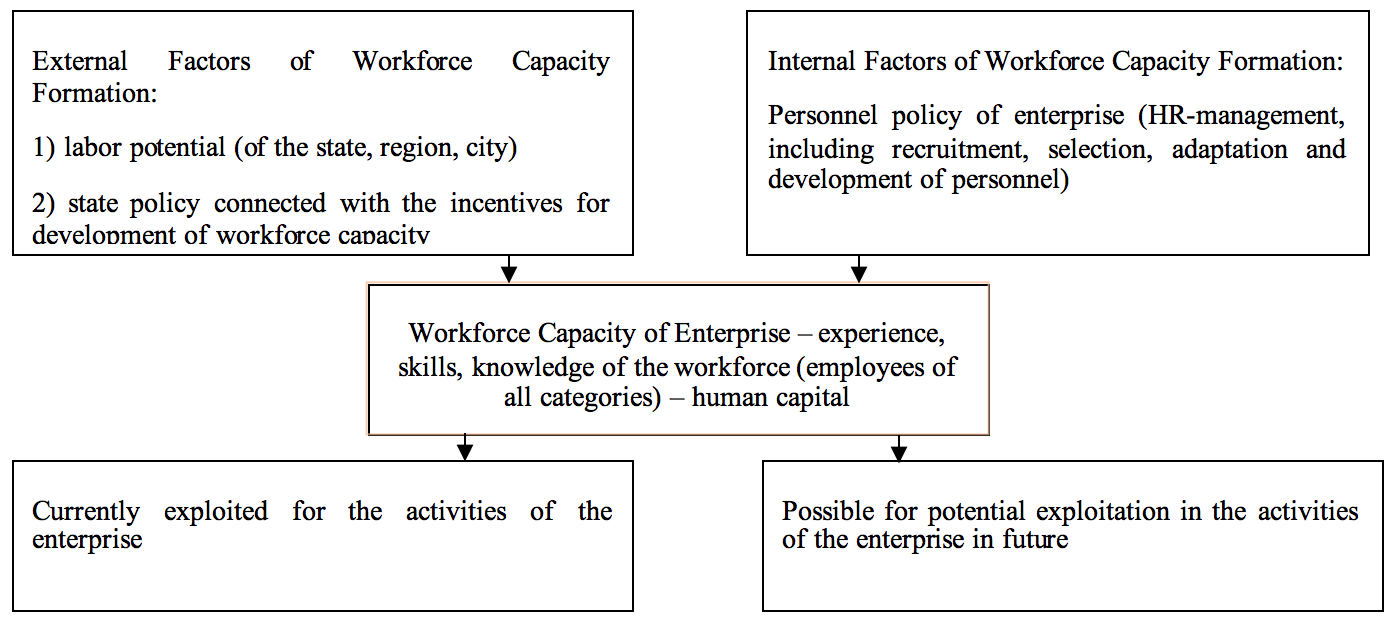
Source: prepared by the author
It means, as represented at Figure 3 by the author, the workforce capacity of an enterprise, which becomes its human capital assets, is connected with the presence of those qualitative characteristics of the personnel that may be used or are being used in the activities of this organization.
Formation of workforce capacity and human capital assets of an enterprise is closely connected with taking the following measures:
– recruitment of the personnel (i.e., purposeful filling of the available vacancies, primarily by the specialists, workers, managers not working at the in order to ensure the work connected with the closed vacant positions);
– selection of the personnel (purposeful selection of the best candidates, including from those already working at the enterprise through their transfer or career promotion);
– adaptation (a form of support and internship for new employees, their supervision by more experienced staff ensuring quick introduction, learning the scope of employment, and acquisition of practical skills);
– development and training (advanced training through on-the-job apprenticeship, or beyond the enterprise using special programs that allow acquiring all the necessary knowledge, competences and skills for more efficient performance of official duties or the duties implied by further career promotion);
– formation and exploitation of the reserve (usually for mid- and high-level managers, and is connected with possible formation of a leadership vacancy with the necessity of its filling from both the lower level executives and the specialists applying for a leading position);
– attestation or other form of personnel assessment (regular check of the knowledge, skills and competences to define to what extent the employee suits for the position taken).
These areas of personnel policy of an enterprise are reflected in the papers by A. K. Butkenova (Butkenova, 2013, p.104), I. M. Chernenko and N. R. Kelchevskaya (Chernenko, 2013, pp. 67-74), A. P. Isayev (Isayev, 2008, pp. 56-59), S. A. Samovoleva (Samovoleva, 2014, p. 63). Summing up the results of their researches one may represent the following algorithm of human capital assets formation under the influence of personnel policy of an enterprise (Fig. 4).
It means all these elements form the team capable of solving both the current tasks of the enterprise’s activities and development tasks if they are to be performed according to the strategy of the enterprise. So, the expenses connected with the recruitment (search, recruitment), adaptation (payment to the supervisor), training and development, advanced training (either payment to the third party or to the employees of the enterprise’s own training center for its maintenance), as well as expenses connected with assessment, formation and keeping the reserve, selection (work of the HR-management department and other executives or experts and persons making final decisions) are formed by each employee of the enterprise. Particularly, the concept of formation of such expenses is reflected in the papers by A. K. Butkenova (Butkenova, 2013, p. 18), E. Ya. Butko (Butko, 2016, pp. 3-9), and V.A. Tetushkin (Tetushkin, 2016, pp. 44-49).
Figure 4
Algorithm of Human Capital Assets Formation under the Influence of Personnel Policy of Enterprise
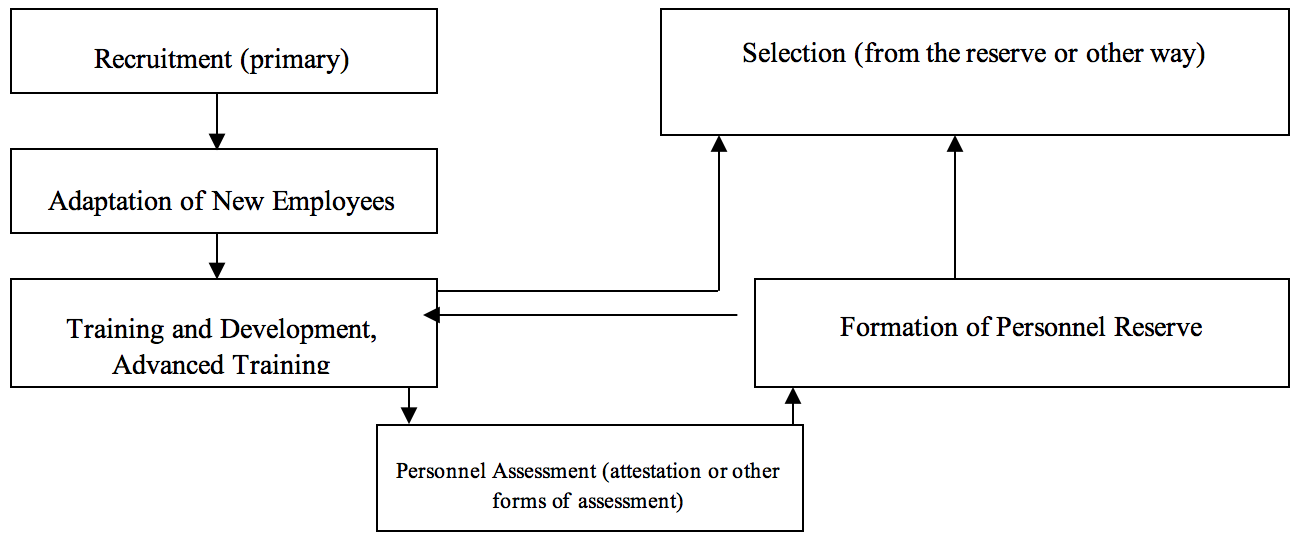
Source: prepared by the author
Recently from the perspective of increase in the efficiency of personnel management and opportunities of applying approaches towards human capital assets, majority of enterprises have fundamentally changed their HR-management. Now the issues of Human Resource Management (HR) are dealt by not only one (personnel department), but several departments and these functions are divided. If in general HR-functions are connected with recruitment, management and support of the activities of the people working in the organization, include all the processes and programs touching upon the human activities as noted by E. Ya. Butko (Butko, 2016, p. 7), then the functions are usually divided by the following areas: personnel record keeping and work (wholly technical function connected with documenting of the personnel turnover, to a greater extent reflexes accounting and legal aspects of HR-function); personnel planning (usually connected with the economy of the personnel, with the incentive aspects, salary system, performance etc.); personnel development (wide range of measures aimed at advancing the qualification of the personnel, their movement inside of the organization, e.g. career promotion, training, development, inclusion into the reserve and exploitation of the reserve), and often recruitment departments of enterprises are exactly formed at these departments responsible for development of personnel in order to ensure increase in the values of human capital assets of the enterprise, which is noted by E. Ya. Butko (Butko, 2016, p. 8), O. M. Aliyev and A. Sh. Aduyeva (Aliyev and Aduyeva, 2017, pp. 13-19).
By human capital assets management strategy one means the one subordinated to the general development strategy of the organization with definition of the goals (achievement of which is necessary for implementation of the general strategy of the enterprise), priorities connected with distribution of the resources for implementation of this strategy and the rules (in this case the methods, directions etc. connected with HR-management) that should be obeyed for implementation of the strategy. It is particularly reflected in the paper by D. I. Vasilyev (Vasilyev, 2016, pp. 215-219). Undoubtedly, strategic management of human resources is connected with a series of methods, programs and policies by means of which one may ensure achievement of the strategic goals. At development and implementation of the human capital assets formation strategy the departments responsible for personnel development should play the key role strongly influencing the decision-making in the strategy at the top-level. All of this may be depicted as follows (Fig. 5):
Figure 5
Human Capital Assets Formation and Development Strategy at an Enterprise
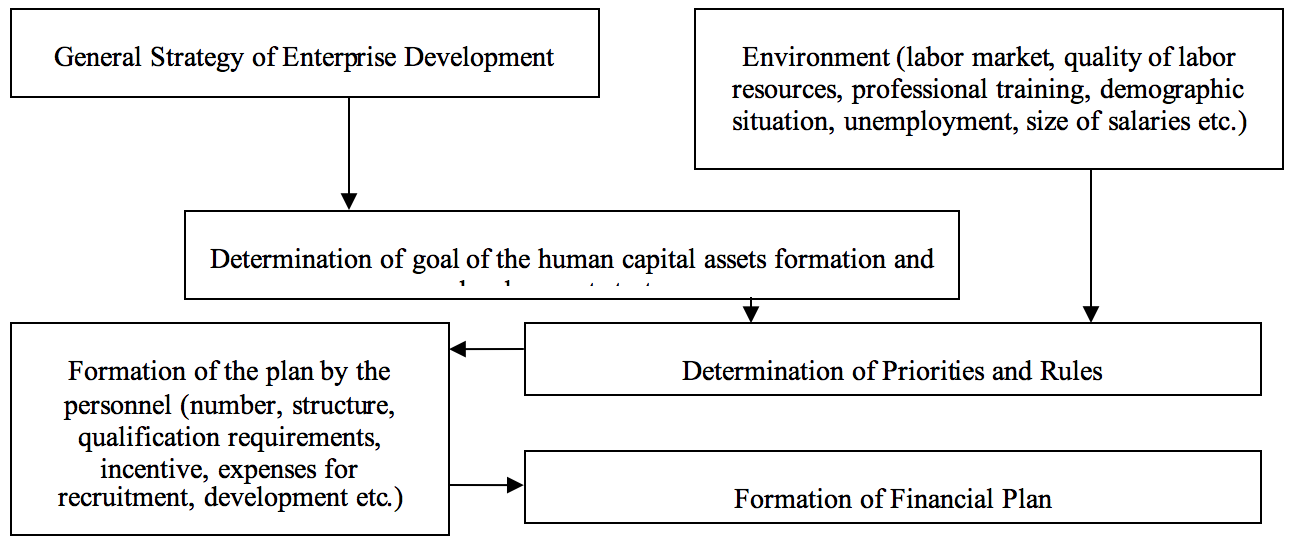
Source: prepared by the author according to (Vasilyev, 2016, pp. 215-219)
It means, summarizing the theory one may conclude that human capital assets are a kind of assets formed under the influence of external factors (labor market of the country and region) and internal factors (personnel policy of the enterprise). Human capital assets reflect the workforce capacity of the enterprise, i.e., the capacity of the workforce to solve both the current tasks and the perspective tasks connected with development. Human capital assets may be assessed, therewith, its quantitative assessment (state of the staff, its structure, turnover and expenses for development) do not fully define the value of human capital assets, but it may be assessed through the applied forms of the personnel assessment (attestation and other), but it is also difficult to perform to the fullest extent. The human capital assets development strategy is closely connected with the development strategy of the enterprise, because human capital assets, being the resource of the enterprise, exactly help implementing this strategy. On the basis of the formed goal the human capital assets formation and development strategy the priorities and rules should be determined and the personnel plan should be formed (not only its qualitative and quantitative characteristics, but also the measures on development and other functions in the framework of HR-management), which lays the basis for performance of the financial plan – expenses for personnel management for a long-term period that are elaborated thereafter as part of the operational budget of the company. That is exactly why large industrial companies with multidivisional structure of HR-management, make personnel management as a separate center of responsibility at budget planning.
The methods used in the process of studying the workforce capacity formation at the Kazakhstani industrial enterprises may be divided into two parts.
First, it is statistical study. It is aimed at investigating the main indicators characterizing the development of human capital assets and the factors reflecting this development and contributing to it:
– size of the workforce (employable population);
– employee population;
– unemployment level;
– number of graduates;
– numbers of workers employed in the industrial sector;
– average salaries (in USD for comparison), including in the industrial sector;
– expenses of the enterprise for training and advanced training of the personnel
Therewith, the statistical indicators dynamic analysis was used (over the period of 2012-2016).
Second, the mid- and high-level managers of 10 Kazakhstani industrial enterprises were surveyed, responsible for the issues of HR-management. In the surveying process the following questions were answered:
how the HR-service of the enterprise is organized;
– what percentage of the enterprise’s expenses is allocated to the HR-functions;
– whether the enterprise has its own training centers;
– whether the enterprise has the system of personnel reserve;
– whether the systems of regular assessment of the personnel quality are used (attestation or other forms) by the enterprise;
– whether the human capital assets development strategies are formed at the enterprise’s strategic planning.
The empirical base of the study is first of all the entire Republic of Kazakhstan, its labor market and industrial sector (complex of the industrial enterprises), and the data reflected in the statistics, provided by KazStat.
For the second stage of the study the mid- and top-managers responsible for the HR-management issues of several industrial enterprises were surveyed (such as: AO “Aluminiy Kazakhstana” (Aluminum of Kazakhstan JSC), AO “Aksuskiy zavod ferrosplavov” (Aksu Ferroalloy Factory JSC), AO “Pavlodarskiy neftepererabatyvayuschiy zavod CCL (Pavlodar Oil Processing Factory CCL JSC), AO “Kazakhstanskiy elektrolizniy zavod (Kazakhstani Electrolytic Factory JSC), TOO “Korporatsiya Kazakhmay” (KZMS PLC), AO “OzenMunayGaz” (OzenMunaiGas JSC), AO Kostanayskiye mineraly” (Kostanay Minerals JSC), AO “ZhayykTeploenergo” (Zhayyk Teploenergo JSC), AO Bayan Sulu (Bayan Sulu JSC), AO Khimfarm (Chimfarm JCS) (10 enterprises).
The study was conducted in four stages:
At the first stage the objective of the study was defined, which was to reveal the extent of strategic planning formation and human capital assets development at industrial enterprises of Kazakhstan.
At the second stage the main statistic indicators were selected, characterizing both the development of the labor market in the Republic of Kazakhstan, and the expenses of the enterprises for the HR-functions (first of all, of the published data on the expenses for personnel training).
At the third stage the survey was conducted, its results were processed and the main conclusions were made on the state of HR-management development at the studied enterprises in general, as well as on the strategic planning of human capital assets at these enterprises.
The conducted study of the statistical indicators allowed composing the following generalizing table that characterizes the situation in the labor market of Kazakhstan in 2012-2016 (table 1):
As can be seen in the represented data the workforce did not almost change over the 5 years and was equal to about 9 million people. Therewith, the number of employees increased by 9.1% over the 5 years, which is connected with the reduction of the self-employed population, and also with transfer of people from rural areas to the cities. Besides, at the same period in Kazakhstan the unemployment level has decreased, especially of youth unemployment (due to development of the economy, growth in demand for youth employees in all the spheres).
Figure 6
Number of University and College Students in Kazakhstan
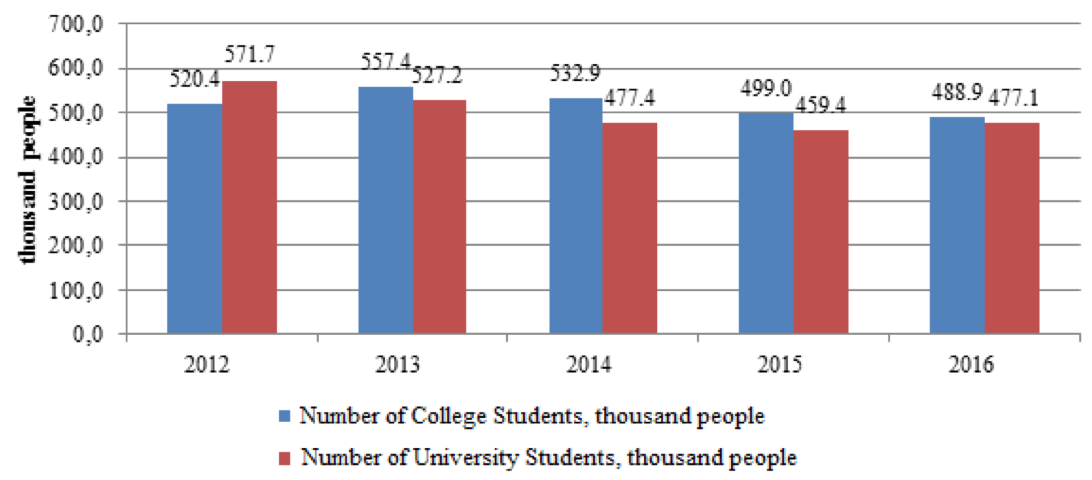
Source: prepared by the author according to KazStat (www.stat.gov.kz)
Therewith over the same period average salary in USD decreased by 38.44% (although it grew in 2013) because of the economic stagnation and devaluation of the last years. Generally the labor market of Kazakhstan cannot be characterized as unthrifty, as it is quite dynamic, the unemployment level is not crucially high, the salaries are also at a rather normal level compatible with the Russian one and are higher than in other states of Central Asia (even despite the decrease). The number of university and college students per each year end is represented at Figure 6.
Table 1
Indicators of Labor Market of Kazakhstan in 2012-2016
Indicator |
Annual Indicators |
Relative Change over the 5 years, % |
||||
2012 |
2013 |
2014 |
2015 |
2016 |
||
Workforce, thousand people |
8981.9 |
9041.3 |
8962.0 |
8887.6 |
8998.8 |
0.19 |
Employee population, thousand people |
5813.7 |
5949.7 |
6109.7 |
6294.9 |
6342.8 |
9.10 |
Unemployment Level, % |
5.3 |
5.2 |
5.0 |
5.1 |
5.0 |
-5.34 |
Youth Unemployment Level (up to 28 years), % |
5.4 |
5,5 |
4.2 |
4.4 |
4.1 |
-23.80 |
Average Salary, USD |
679 |
717 |
675 |
568 |
418 |
-38.44 |
Source: prepared by the author according to KazStat (www.stat.gov.kz)
It means, the expenses for HR-management amount for 0.25-0.31% of the volume of industrial production of the Kazakhstani enterprises which is generally not much (Table 2).
Thus one may make the following conclusions regarding the obtained statistical data. In Kazakhstan the industrial sector as a complex of economic branches (from mining production to processing) forms over 40% of the GDP. At the same time the percentage of the people employed in the industrial sector is about 10% (over 5 years the percentage decreased from 12.1 to 9.7%).
Table 2
Indicators of the Industrial Sector of Kazakhstan, and HR-Expenses of the Industrial Enterprises in 2012-2016.
Indicator |
Annual Indicators |
Relative Change over the 5 years, % |
||||
2012 |
2013 |
2014 |
2015 |
2016 |
||
Industrial Production, KZT billion |
16851.8 |
17834.0 |
18529.2 |
14903.1 |
19026.8 |
12.91 |
Percentage of Industrial Production in GDP, % |
54.3% |
49.5% |
46.7% |
36.5% |
40.5% |
-25.45 |
Number of Employees in Industrial Sector, thousand people |
701.2 |
695.3 |
685.1 |
627.9 |
615.6 |
-12.21 |
Percentage of Industrial Employees in the General Number of Employees, % |
12.1% |
11.7% |
11.2% |
10.0% |
9.7% |
-19.53 |
Average Salary in Industrial Sector (monthly average USD) |
706.9 |
720.9 |
702.5 |
611.6 |
632.2 |
-10.57 |
Expenses for Development of Personnel of Industrial Enterprises, KZT billion |
52.2 |
53.5 |
50.0 |
43.2 |
47.6 |
-8.95 |
Percentage of the expenses for personnel development in the total volume of industrial production, % |
0.31% |
0.30% |
0.27% |
0.29% |
0.25% |
-19.35 |
Source: prepared by the author according to KazStat (www.stat.gov.kz)
Importantly, it happens due to reduction in the number of people employed in the industrial sector. It also became possible due to optimization of number of personnel at many enterprises, including due to the economic stagnation as well as mechanization and automatization of many processes (which allowed decreasing labor intensity). The environment influencing development of human potential in the industrial are of such a nature that at growth of the population of Kazakhstan, increase in the number of human resources and even at some reduction of unemployment level, the quality of the labor resources decreases due to the decrease in the specialists’ training level at colleges and universities. Therewith, in the situation of crisis the salaries decreased both generally in the state’s economy and particularly in the industrial sector (but here they are higher than generally in the economy). It is also noted that the enterprises do not spend significant expenses for HR-functions: they amount for about 0.25% from the total production volume.
Figure 7
Answers to Question: “What way is the HR-Service organized in your Company?”
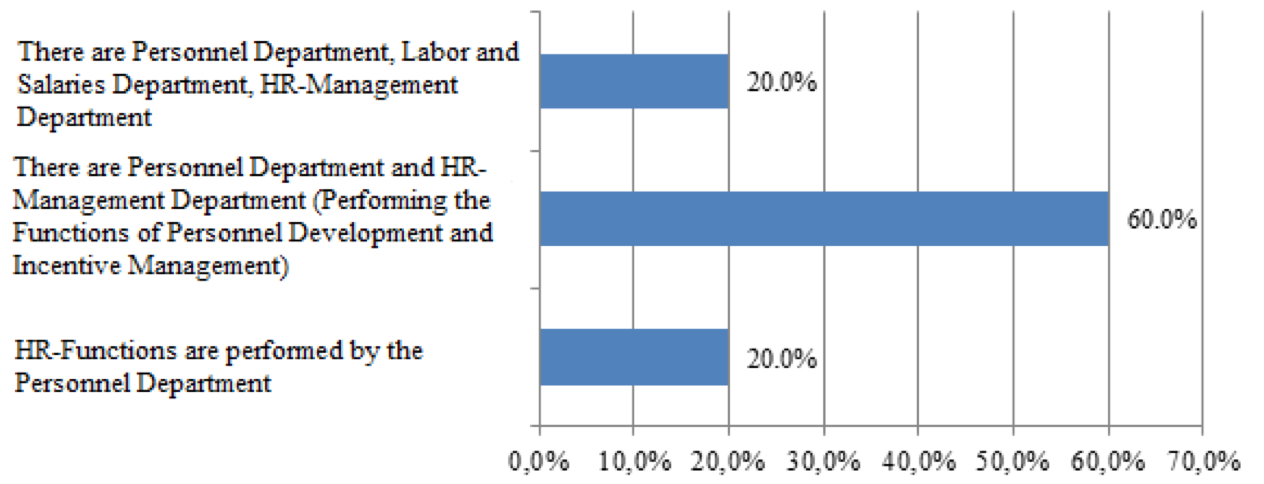
Source: prepared by the author according to the results of the conducted survey
The results of surveying the enterprises that were chosen and described earlier provided the following results. The first question was description of the HR-department of the enterprise. The distribution of the answers is represented at Figure 7.
It means the majority of the enterprises have two departments: the first deals with the staff documentation, while the second – with the issues of incentive, personnel development, analysis etc., though 20% of the surveyed enterprises transferred the functions of incentive management, analysis etc. to a separate department.
The answers to the question about presents of its own training center were distributed as follows (Fig. 8).
Figure 8
Answers to Question: “Are there Training Centers in your Company?”
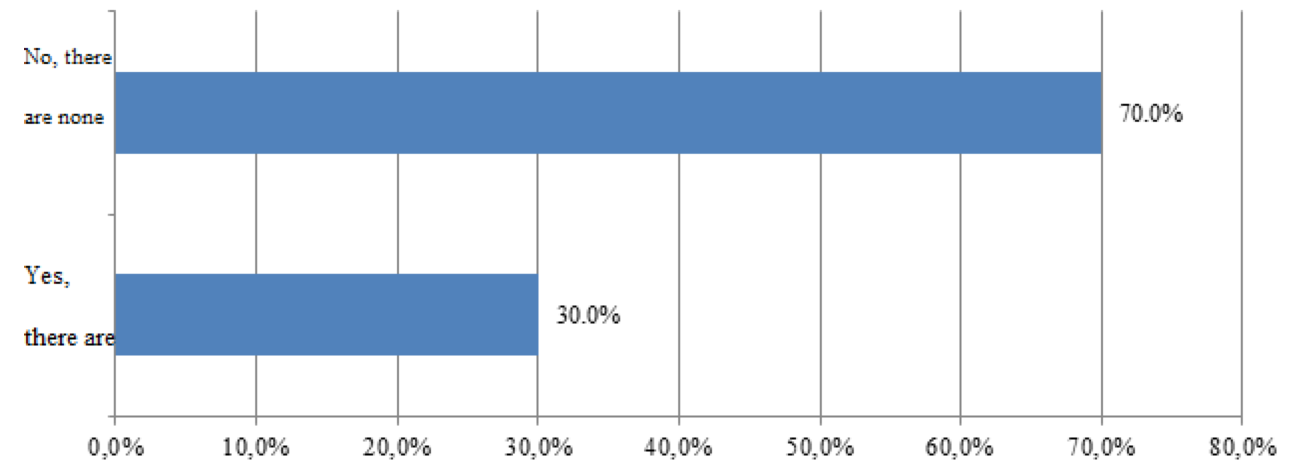
Source: prepared by the author according to the results of the conducted survey
It means the majority of the investigated enterprises do not have their own centers; only 30% have them, which is quite logical, considering the complexity of maintenance of such departments and greater simplicity of outsourcing in this sphere.
The answers to the question about the personnel reserve system were distributed the following way (Fig. 9).
Thus a half of the investigated enterprises have no personnel reserve system, and only 10% have this system for all the employees, which is very few.
Figure 9
Answers to Question: “Is there a Personnel Reserve System in your Company?”

Source: prepared by the author according to the results of the conducted survey
The answers to the questions about personnel assessment were distributed as follows:
Figure 10
Answers to Question: “Are there Systems of Regular Assessment of
the Personnel Quality (Attestation or other Forms) in your Company?”

Source: prepared by the author according to the results of the conducted survey
Thus, there are also no such a system of personnel assessment at significant percentage (40%) of the enterprises, while for assessment of all the employees such system exists only at 10% of the investigated enterprises. And the assessment is mainly conducted either among the executive employees also considering ESW.
Answers to the question about formation of the development strategy distributed as follows (Fig. 11).
Figure 11
Answers to Question: “Is the Human Capital Asset Development
Strategy included into the strategic plans of the enterprise?”

Source: prepared by the author according to the results of the conducted survey
It means the majority of the surveyed enterprises actually develop no such plans, but 30% develop them as a long-term plan as part of the general strategy. A particular document of the plan is developed only by 10% of the respondents.
When answering the question about setting of HR-service aside as a separate responsibility center at budget (financial) panning at the enterprise (i.e. when this responsibility center independently plans its functions, expenses, including them into the general budget of the enterprise the data on the HR-service) there were the following results (Fig. 12).
Figure 12
Answers to Question: “Is the HR-Service set aside as a
Separate Responsibility Center at Budget Planning?”
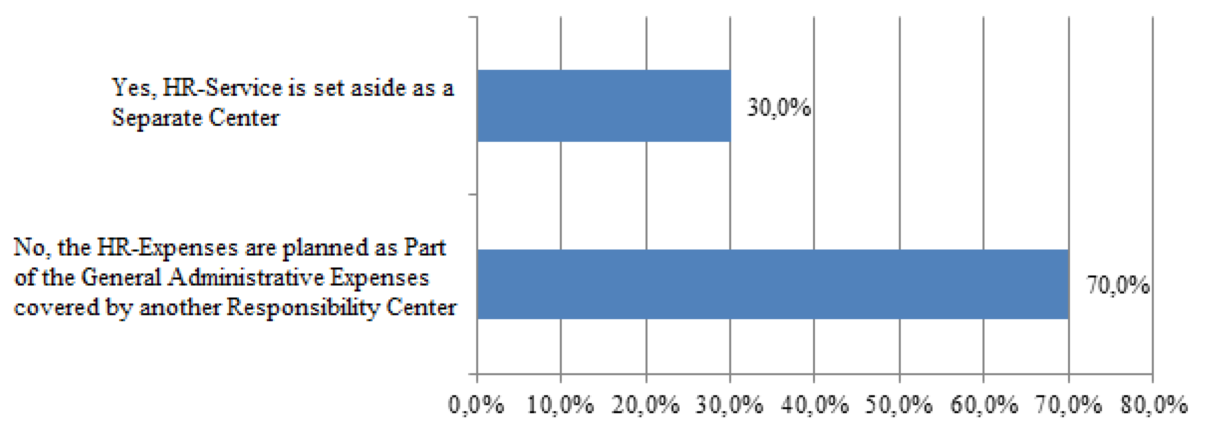
Source: prepared by the author according to the results of the conducted survey
It means, for the majority of the enterprises the HR-expenses are not something as significant for them to set aside such expenses into a separate responsibility center thus increasing their importance in the financial expenses of the enterprise.
When answering the question about the percentage of the expenses for HR-functions the average values were considered, earlier noted in the statistical data (0.25% of the production volume – actually of the expenses of the enterprise, i.e. the prime cost) (Fig. 13):
Figure 13
Answers to Question: “What is the Percentage of the
Enterprise’s Expenses allocated to the HR-Service?”
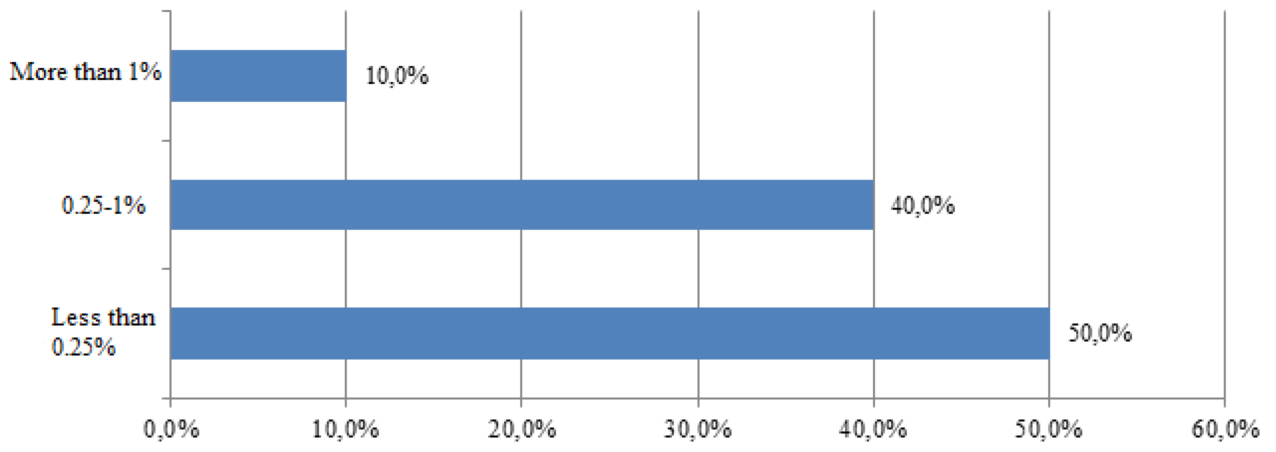
Source: prepared by the author according to the results of the conducted survey
Thus a half of the enterprises spend for HR-functions the expenses that less than the average level of the industry, although 40% - more than it, but less than 1% of the expenses. More than 1% is spent by only 10% of the investigated enterprises.
It may cause the conclusion that the personnel management at the industrial enterprises of Kazakhstan is currently below the level necessary for significant improvement of the human capital assets quality. It is connected with the fact that the executives of many enterprises do not understand the importance of HR-management and personnel development strategy, and also with the situation of crisis at many enterprises, and austerity for general administrative expenses.
Considering the discovered problems connected with development of human capital assets in Kazakhstan, and with the strategical planning system of human capital assets at the Kazakhstan enterprises, one should understand what exact problems are noted by the other authors.
So, А. Nurbayev, investigating the issues of strategic management at large enterprises (Nurbayev, 2011, pp. 55-62) notes that the current situation in the HR-management at large Kazakhstani enterprises may be characterized by the following trends: multiple problems and deformation of the processes of workforce capacity reproduction of the society by itself, sue to, particularly, the outflow of the most qualified staff abroad, decrease in occupational prestige of a series of useful and necessary kinds of activities and professions for society, weakening of the incentives in the society to the constructive and socially useful labor in the conditions of excessive development of nonproductive activities, including guarding, mediation etc. Besides, the author also noted the fact that the modern society imposes a significant amount of requirements to the enterprises thus setting more and more limitations. And nevertheless the large corporations are expanding and developing, while smaller enterprises stagnate. In the economy of Kazakhstan the role of large companies as the main employers increases in the context of their importance for development of the potential of workforce and society. And all this is caused by such companies’ opportunities as financial, organizational and material-technical. But here currently the focus has also shifted to the social role of such companies, because for example, in the developed economies technical and technological functions and organizational efforts aimed at increase in the competitive advantage of large companies will cause no desired effect if they are not focused on human factor. There is also an urgent need in making systemic and complex the work connected with personnel development at all the levels, which implies in-depth comprehension of the theory and methods connected with this issue. Nowadays the potential of the traditional method of human resources management based on technocratic approach is already almost exhausted, because the equipment and technologies ultimately change together with the quality characteristics of the workforce causing the human factor, workforce capacity and human capital assets to take the prioritized position. Today the most important role becomes the personality of manager and of each employee of an organization, from executive to front-line worker. The competitive advantage of an individual is seen as his or her age, professional, qualification, physiological, and social characteristics complying with workforce employment terms formed in the labor market, reflect the demand and supply for a specific quality workforce. The competitive advantage as a capacity for labor shows qualitative side of labor potential of every person. The competitive advantage thus influences the specifics of his or her labor behavior as well as the extent of realization and development of personal labor potential, which is a general rule. Such a labor competitive advantage has great incentives in the system of large enterprises, but it does not have them among others, economic entities less in the size.
On the other hand, in the modern conditions the investments into human capital assets may not always be justified. So, A. Zh. Turegel’dinova elaborates that in the conditions of unstable economy, high inflation, market fluctuation there are few businesses that are ready to invest into such development without seeing the long-term perspectives and having any opportunities for building long-term strategies (Turegel’dinova, 2010, pp. 93-97). Comparing the modern market situation in Kazakhstan with that of the developed countries (Japan, Germany and the USA), the author elaborates that those countries have rather stable traditions formed over a long period together with relations in this sphere, there is also “life-long recruitment” system in Japan also including the incentive, retaining the employee (so there is a sense in investing in his or her development), high salaries causing low staff turnover in the spheres and professions requiring investments in development of the employees.
A. A. P. Isayev also elaborates that even the presence of the personnel management system, the human capital assets development strategy in a company do not guarantee efficient development of human capital assets, because the problems may be both in the HR-departments’ work organization and qualification of their personnel, and in wrong choice by the top-managers of the HR-strategy implementation methods (Isayev, 2008). It means, the drawbacks of the HR-departments may also be revealed in the fact that their specialists:
– have not enough professionalism in using the HR-technologies;
– do not know the modern process and technologies of industrial enterprises and thus the demand for the personnel in their different departments;
– have routine processes prevailed in their work, which by no means influence the human capital assets development.
On the other hand, both the top-managers and heads of production regardless of their basic education, by criticizing the work of HR-departments, have no full idea of the functions, content and methods of HR-management. As they have no professional knowledge and competences in this sphere, then the management of such work, participation in it, and delegation of such functions to the departments not directly connected with HR, is implemented based on ‘common sense” inly in accordance with the stereotypes of organization culture.
And the both problems cause improper or inefficient application of the HR-methods, for example:
– using the services of labor market consultants (business trainers, coachers etc.), the work of whom may not always be effective for human capital assets development;
– using the HR-programs aimed at solution of personnel issues becomes a means of “stop-gapping”, as there is no system strategy and thus there are no goals and tasks of recruitment and selection of personnel;
– activation of HR-management, including attraction of experienced consultants is not a systematic work aimed at a specific goal.
It means, HR-management will be efficient only when the two core factors are considered and used. The first one is a certain production task for solution of which the HR-management is designed. The second factor is the key idea aimed at implementation of the personnel strategy of the enterprise. The second factor unites all the forms and kinds of HR-management creating the conditions necessary for solution of all the current tasks of the enterprise. They ensure readiness for solution of those tasks that will emerge or are planned to emerge in the nearest future in accordance with the strategy. The greatest effect in HR-management will be achieved only when the two represented factors are harmonically interconnected. At the same time, the first factor will ensure the prioritized direction of the HR-management, while the second one ensures the efficient implementation of the company’s strategy.
Summarizing the results one may make the following conclusions. Generally, human capital assets are a kind of non-material assets of a company (it may be assessed as a part of the goodwill, but it is difficult to assess it). Its formation influences the quality of the enterprise work and thus the quality of the released products, if speaking about industrial enterprises. Human capital assets, being the workforce capacity of a company, are formed under the influence of external conditions and internal factors (connected with the extent of development of the personnel policy of the enterprise, and its HR-management). It reflects the capacity of the workforce for solving both the current tasks and the perspective tasks of the enterprise’s activities. Assessment of the human capital assets may be quantitative (it is superficial, assesses only the composition and movements of the personnel, expenses for it, but does not consider deep processes) and qualitative (by means of various forms including attestation). The human capital assets development strategy stems from the development strategy of the enterprise, and the priorities and rules of work with the personnel are determined on the basis of the formed goal, the plan on personnel is also formed (by the composition, structure, salary and the functions connected with HR-management), which forms the basis for financial plan. Personnel management at modern large enterprises is usually divided into HR-management connected with documentation, economic planning, salaries, incentive, and expenses for personnel and analysis of the performance, and HRD-management, including recruitment, selection, adaptation, training, advanced training, development, inclusion into the reserves and their exploitation. The work of the HRD-departments is closely connected with the work of other departments of the company requiring solution of tasks of human capital assets development.
Research of environment for human capital assets development in the industrial sector has shown that at growth of the population and labor resources in Kazakhstan there are currently some problems concerning reduction of salaries. Therewith the quality of the personnel training worsens – the number of the colleges and universities students decreases with the increase of the population. Moreover, in the industrial sector the number of employees also decreases – it is being optimized up to the level necessary for the current volumes of production considering mechanization and automatization of many processes as well as the situation of crisis at many enterprises. Therewith, average salaries in the industrial sector are slightly higher compared to those in general in the country. One may also note that the investments of industrial enterprises into development of the personnel are not very high, which is explained by the economy, especially in the period of the crisis.
The research of HR-management by the results of the heads of the HR-departments of 10 industrial enterprises in different parts of Kazakhstan has shown that personnel management at the industrial enterprises of Kazakhstan is still not at the level necessary for significant improvement of human capital assets quality, required for transfer from resource-based to innovation economy. It is also connected with the lack of understanding by leaders of many enterprises that HR-management and personnel development strategy are important, and also with the deficiency of financial resources also caused by the crisis situation at many enterprises, and austerity at general running expenses (which also include those for personnel management).
Therewith, in the modern industrial sector, human capital assets are the defining factor in ensuring high competitive advantage. Now equipment and technologies already play less important role, because the equipment is constantly being updated, while technologies become more and more universal. Just exploiting the workforce is not enough, it is necessary to attract such a workforce that would be able to perform more complicated tasks and ensure the development. Therefore, large companies throughout the world invest much into the development of workforce capacity, into training and improvement of the employees with a significant focus on the system of personnel selection. In Kazakhstan in the modern conditions it is difficult to implement. However, large companies are capable of it even now, and the expectations in this sphere are laid exactly upon them. It is important that managing the personnel policy, development of the personnel one cannot make mistakes caused by both incompetence of HR-department and top-management or production management of a company. It requires efficient combination of two main factors of proper HR-management: it should be built for specific production tasks and should respond to the key idea of the personal strategy and general development strategy of the enterprise.
Considering the aforesaid, one may develop a series of recommendations aimed at increase in the efficiency of strategic planning and human capital assets management at the industrial enterprises of Kazakhstan. First of all, large enterprises should form the strategy of personnel management that corresponds to the general strategy of development, stems from it and is aimed at solution of the tasks described in the general development strategy. Besides, the personnel department of an enterprise should be precisely segmented into recording, economic and personnel development department, and exactly the development department should deal with selection, recruitment, reserve, training and advanced training, and also efficiently interact with the production, technical engineering and management departments of the enterprise in order to build the work for satisfaction of the personnel’s needs. Moreover, introduction of such instruments as assessment of the personnel, formation and use of the reserves should be pervasive. It is necessary to begin with large companies partially owned by the government. At the control on the part of the state it will be easier to perform all these tasks. And private companies may form their own systems by the example of those formed by the state enterprises, if they see the efficiency of the latter.
Vukovich, G.G., Khil’ko, D.A. (2012). Labor Market and Employment Problems in the RF. Society: Sociology, Psychology, Pedagogics, 3, 16-20.
Igoshina, K.E. (2016). Problems of Russian Labor Market and Main Directions of State Policy for Regulation of Employment. Retrieved from: http://nauka-rastudent.ru/36/3871/ (accessed June 30, 2017)
Mustafina, L.E. (2015). Russian Labor Market: Problems and Tendencies. Retrieved from: http://sci-article.ru/stat.php?i=1448300971 (accessed June 18, 2017)
Shustova, N.N. (2011). Russian Labor Market: Problems and Tendencies. Problems of Modern Economy, 4 (40), 25-29.
Akhatova, E.Kh. (2014). Analysis of Modern Conditions and Trends in the Development of Workforce Capacity in Kazakhstan. Retrieved from: https://articlekz.com/article/9233 (accessed June 15, 2017)
Iskendirova, S., Aglankyzy, D. (2015). Analysis of Modern Conditions and Trends in the Development of Workforce Capacity in Kazakhstan. Retrieved from: https://infourok.ru/statya-po-ekonomike-analiz-sovremennogo-sostoyaniya-i-tendenciy-razvitiya-trudovih-resursov-v-respublike-kazahstan-488175.html (accessed July 15, 2017)
Selimova, S.A. (2016). Problems of Labor Market in the Russian Federation and Ways of their Solution. Materials of the 9th International Students Scientific and Practical Conference. (Cheboksary, May, 31 2016). Cheboksary: Interaktiv Plus.
Ivanov, R. (2017). Paradoxes of Unemployment in Kazakhstan: Growth in the Deficiency of Workforce and the Number of Unemployed. 365-INFO. Retrieved from: https://365info.kz/2017/05/realnaya-bezrabotitsa-v-neskolko-raz-prevyshaet-ofitsialnuyu-statistiku-eksperty/ (accessed July 2, 2017)
Yermekbayeva, B. Zh., Mukhtarova, K. S. (2016). HR-Management in the Conditions of Innovation Economy of Kazakhstan. G-Global. Retrieved from: group-global.org/sites/default/files/publications/af%20%282%29.doc (accessed July 15, 2017)
Balashov, A.P. (2009). Introduction to Management. Мoscow: University Textbook.
Balashov, A.I., Kotlyarov, I.D., Sanina, A.G. (2012). HR-Management. Saint Petersburg: Piter.
Sheshukova, T.G, Kolesen’, E.V. (2011). Economic Potential of an Enterprise: Essence, Components and Structure. Herald of Perm University. Series: Economics, 4(11), 118-127.
Vasilchenko, V.S., Grinenko, A.M., Grishnova, O.A., Kerb, L.P. (2005). Workforce Capacity Management. Кyiv: Kyiv National Economic University.
Berglezova, Т.V. (2015). Notion of Workforce Capacity and its Influence on Performance of an Industrial Enterprise. Corporate management. Retrieved from: http://www.cfin.ru/bandurin/article/sbrn08/07.shtml (accessed July 15, 2017).
Sukhodoyeva, L.F. (2007). Workforce Capacity of an Enterprise. Economics and Finances: Herald of the Lobachevsky State University of Nizhni Novgorod, 3, 165-167.
Schultz, T. (1968). The International Encyclopedia of Social Sciences. Human Capital. New York.
Khudobko, E.V. (2011). Peculiarities of Formation and Properties of Human Capital Assets. Herald of the Bryansk State University, 7, 7-17.
Zulpuyev, A.M., Primov, E.B. (2016). Human Capital Assets in the Modern Society. Territory of Science, 6, 68-75.
Atamanchuk, G.V. (2014). Theory of State Management. Мoscow: Omega-L.
Mirosedi, S.A., Schedrina, A.V. (2014). Methods for Assessment of Workforce Capacity of an Enterprise. Retrieved from: http://www.volpi.ru/files/publications/S__A__Mirosedi__A__V__SCHedrina_Metody_ocenki_kadrovogo_potenciala_predpriyatiya.pdf (accessed August 15, 2017)
Butkenova, A.K. (2013). Human Capital Assets in the Market Economy. 3rd Republican Scientific and Practical Conference of Young Scientists and Students “Cooperation of Science and Business: Problems and Future”. Ust-Kamenogorsk: Sarsen Amanzholov East Kazakhstan State University.
Chernenko, I.M., Kelchevskaya, N.R. (2013). HR-Management at an Industrial Enterprise. Collection of Research Papers Sworld, 35 (3), 67-74.
Isayev, A.P. (2008). Model of HR System Management in an Industrial Enterprise. Herald of the Kalashnikov Izhevsk State Technical University, 2, 56-59.
Samovoleva, S.A. (2014). Problems of Formation of Innovative Strategies at the Russian Enterprises: Provision with High Quality Human Resources. Collection “Strategic Planning and Development of Enterprises based on the Materials of the Fifteenth Russian National Symposium”. Moscow: RPI.
Butko, E.Ya. (2016). HR-Management. Educational Resources and Technologies, 5 (17), 3-9.
Tetushkin, V.A. (2016). HR-Management: International and Russian Experience. Management in Russia and Abroad, 5, 43-50.
Aliyev, O.M., Aduyeva, A.Sh. (2017). HR Requirements in the Modern Economic Conditions. Herald of the Dagestan State University. Series 2: Social Sciences, 32 (1), 13-19.
Vasilyev, D.I. (2016). New Explanations of such Notions as “Human Resources”, “HR-Management” and Strategic Personnel Management in Banks. Economics and Management of Innovation Technologies, 12 (63), 215-219.
Nurbayev, A. (2011). Methods of Strategic HR-Management in Large Groups of Companies and Corporations. Herald of the Kazakh National University, 4, 55-62.
Turegel’dinova, A.Zh. (2010). HR-Management in Foreign Countries. Reports of the National Academy of Science of the Republic of Kazakhstan, 4, 93-97.
1. Graduate student. National Research Nuclear University MEPhI, Financial Academy. Republic of Kazakhstan. E-mail: butkenova@mail.ru